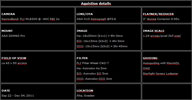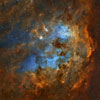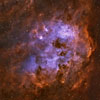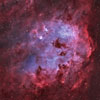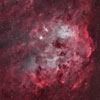The image features two remarkable inhabitants of the cosmic pond of gas and dust above and left of center, the tadpoles of IC 410. Partly obscured by foreground dust, the nebula itself surrounds NGC 1893, a young galactic cluster of stars that energizes the glowing gas. Composed of denser cooler gas and dust the tadpoles are around 10 light-years long, potentially sites of ongoing star formation. Sculpted by wind and radiation from the cluster stars, their tails trail away from the cluster's central region. IC 410 lies some 12,000 light-years away, toward the constellation Auriga.
The above text is taken from NASA APOD.
This image is built from five different combinations of three narrowband images (Ha, OIII and SII).
The first one is the familiar Hubble composition added with a colour shifting using Photoshop's Selective Color tool (see Bob Frankes tutorial). One has to be very careful when using the Selective Color tool in PS, since it is easy to shift to much resulting in sharp borders between blue and yellow.
The second one is a modification to the Hubble composition. Instead of assigning Ha to green I assigned Ha to orange (Hue = 35 in PS notation), SII to red (as in Hubble) and OIII to a slightly more turquoise hue (Hue = 210 in PS notation). This palette has the advantage of separating the different narrowband images (as do the Hubble composition), but has the advantage of not being dependent on careful usage of the Selective Color tool.
The fourth one is an attempt at mapping the narrowband images to colours so that the image would mimic the result of a broadband RGB image. It has been constructed by using the fact that H-beta emission (blue) accompanies the H-alpha line (red) with H-beta roughly 15% of the strength of the H-alpha. To the best of my knowledge this was first suggested by Richard Crisp. It also uses the fact that OIII is positioned in-between the blue and green part of the spectra. A litte bit of SII is added to the red channel.
The third and fifth image are variations of the fourth in the way one treats the OIII data. In the fifth I have decreased the OIII contribution in order to make the nebula redder - which is perhaps closer to a real representation. In the third I have pushed the OIII data more towards blue to show the OIII regions better, but still in a red nebula representation.
In order to make most use of the weak OIII and SII data I have also used JP Metsavainio's Tone Mapping technique. A pdf that outlines tone mapping can be found here, and in order to bring out as much details as possible I have followed some of the tutorials on Ken Crawford's site.
By "mouse over" on the thumbnails above you can see:
- Image details: Equipment used, number of subs etc.
- Hubble: Red = SII, Green = Ha, Blue = OIII, Lum = Ha + OIII + SII. Then shifting colours.
- Hubble modified: Orange = Ha (hue=35), Red = SII (hue=0), Blue/Turquoise = OIII (hue=210) , Lum = Ha + OIII + SII.
- Artificial RGB (ARGB): Red = 80%Ha + 20%SII, Green = OIII, Blue = 85%OIII + 15%Ha, Lum = Ha + OIII + SII
- Artificial RGB with less O3 (ARGB less O3): Same as ARGB but the OIII contribution has been dialled down to get closer to a real RGB image.
- Artificial RGB with O3 blue (ARGB O3 blue): Same as ARGB but the OIII contribution to the blue channel has been dialled up to make the OIII area more visible.
Click on the image name in the list to load a larger version.
Below you see images for each emission line respectively. The images has been stacked and stretched so that the histogram peak is equal for each of them. Note that the binning of the OIII and SII data was 3x3. This mean that each pixel receives 9 times as many photons compared to 1x1 binning. Thus a 4hr exposure would correspond to a 36hr exposure binned 1x1. Binning 3x3 of course looses detail, which in this image has been compensated by constructing a luminance using the H-alpha image with a touch of the OIII and SII data in it.

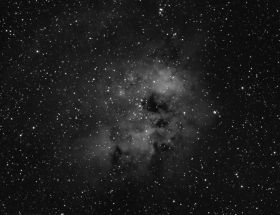
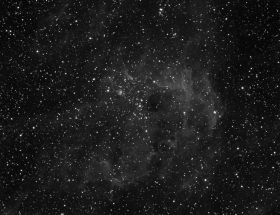
Ha OIII SII
The following software has been used. MaximDL (image acquisition and guiding), CCDStack (calibration and RGB scaling, PixInsight (cropping, background correction, colour corrections) and Photoshop CS5 (all the rest, incl Noel Carbonis Astronomy Tools), and finally JP Metsavainio's Tone Mapping technique.
This image was processed in April 2012
Copyright: All images © 2011 Matts Sporre. All Rights Reserved



